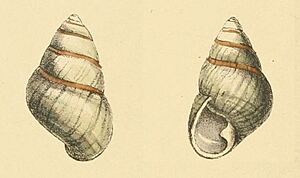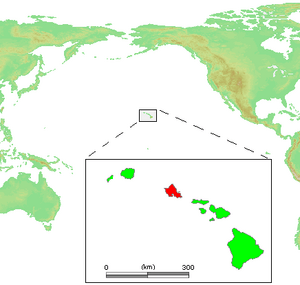Achatinella livida facts for kids
Quick facts for kids Achatinella livida |
|
|---|---|
 |
|
| Drawing of a shell of Achatinella livida. | |
| Conservation status | |
| Scientific classification | |
| Genus: |
Achatinella
|
| Species: |
livida
|
 |
|
| Location of Oʻahu | |
Achatinella livida is a very rare type of land snail. It breathes air, just like us! This special snail belongs to a family called Achatinellidae. You can only find Achatinella livida on the island of Oʻahu in Hawaiʻi. This means it is endemic to Oʻahu, living nowhere else in the world.
What Does It Look Like?
The shell of an Achatinella livida snail is quite unique. It can grow up to 17 millimeters (about 0.67 inches) long. The shell is shaped like a cone and has a pointed top. It can have up to six spiral sections, called whorls.
The color of these shells ranges from a dull brown to a lovely purple. The very tip of the shell often fades into a white color. There is also a clear line separating the shell's sections. This line is usually a deep orange-brown color.
Where Does It Live?
Achatinella livida snails live only in the northern part of the Ko’olau mountains. These mountains are located on the island of O'ahu in Hawaiʻi.
They prefer to live in moist forest areas. You can often find them on a specific type of tree. This tree is called Metrosideros polymorpha, also known as 'Ohi'a lehua. This is their natural home.
Why Is It Endangered?
Achatinella livida is considered critically imperiled. This means it is in extreme danger of disappearing forever. In 2014, scientists estimated there were only about 76 of these snails left in the wild.
Like many Hawaiian tree snails, Achatinella livida faces several threats. One big problem is habitat loss. This happens when their forest homes are destroyed or changed. Another major threat comes from other animals. A snail called Euglandina rosea is a predator that hunts and eats these native snails. Other predators also pose a danger.
To help save them, some Achatinella livida snails are kept in special care. In 2014, there were 25 snails living in captivity. This group included three adult snails. This captive breeding program started in 1997 with 13 adults. The goal is to protect them and hopefully help their numbers grow.




